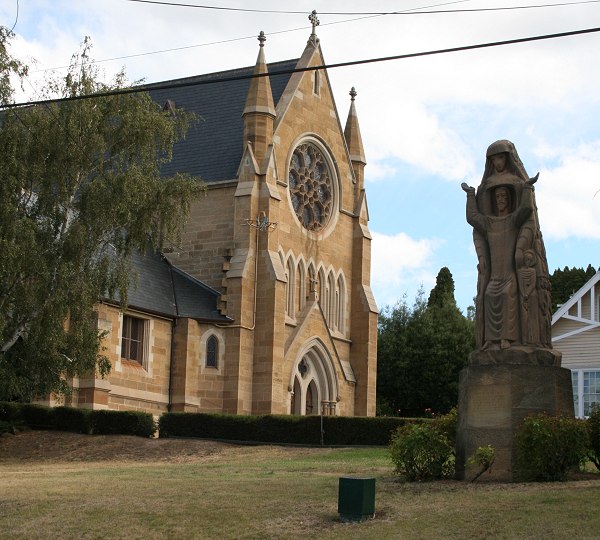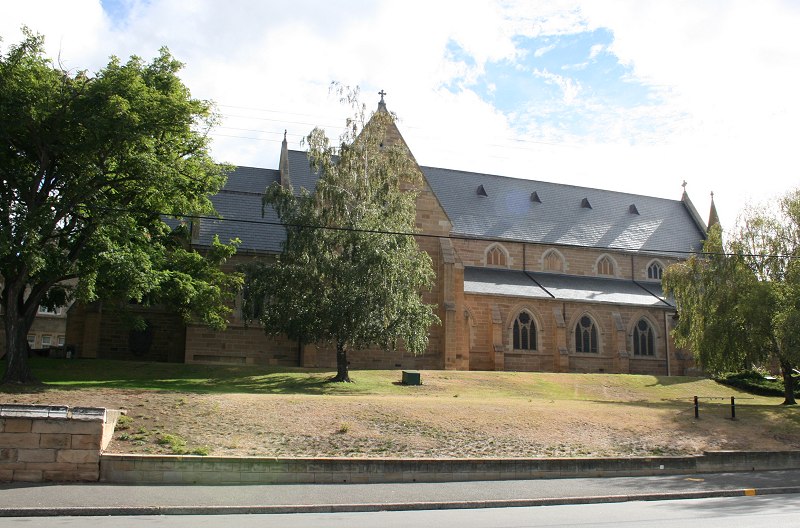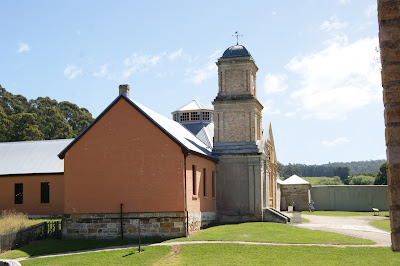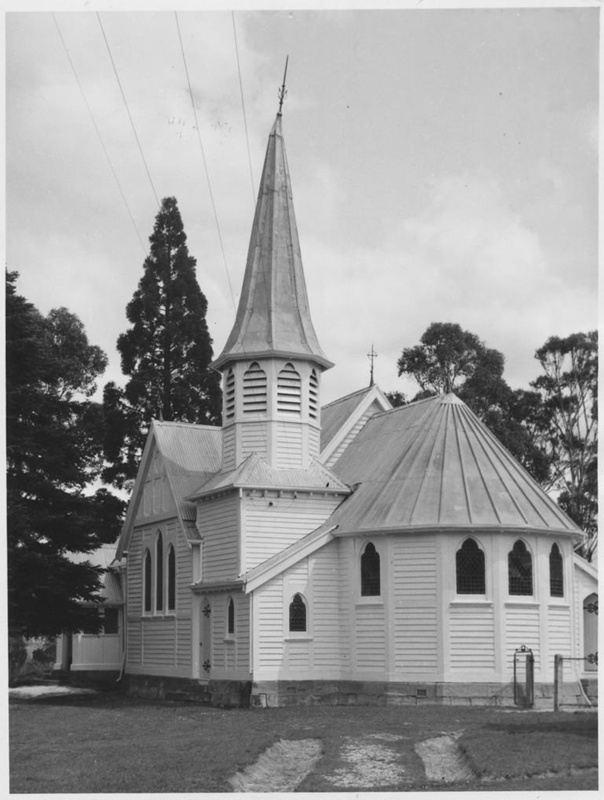Tasmanian Architect George Fagg
Architect of many Churches, in Hobart (eg Baptist Church) and in other towns of Tasmania, and of High Peak, Neika
Proficient Architect of the 'Queen Anne' style, also renowned for Federation Extensions to BishopsCourt, Hobart
[Previous Post: High Peak, Neika .... Next Post: Queen Anne Masterpieces]
Table of Contents
 |
| 'Boom' (Queen Anne) Architecture of George Fagg |
- Related: Queen Anne, Gothic Queen Anne style
- NOT the Qld George Fagg, NOT William George Fagg, his son (see below)
 |
| Tasmanian International Exhibition, Launceston 1891/92 |
George Fagg, Architect, Elizabeth St., Hobart (1848 - 1897)
- British architect George Fagg M.S.A. arrived in Tasmania in 1885 and died at Claremont, 16 December 1897.
See death notice in the Mercury Hobart December 17th 1897, p. 1. (reproduced below) - George Fagg practised as an architect in his office in London and in 1885 left with his son for Tasmania where they practised in Hobart for about ten years.


- George Fagg won the Tasmanian Exhibition Medal in 1891 for Architectural Drawings
- In Tasmania, a series of arts and industrial exhibitions led up to international exhibitions held in Launceston in 1891/92 and Hobart in 1894/95.
- The Tasmanian Exhibition, staged in Launceston over four months in the summer of 1891-1892, was the biggest event ever to be held in Launceston, attracting some 262,059 visitors.
- "The exhibition had effectually removed the slur cast upon Tasmania by people who called it Sleepy Hollow, for it had shown that its people could do as well as any others, perhaps better." - p 16.
- He also conducted a major renovation of Theatre Royal in 1890.
See tender notice: Geo. Fagg, Hobart. Tenderers listed for alterations to Theatre Royal, Hobart, in the Australasian Builder and Contractor's News 24.5.1890.- Father of William George Fagg, an architect who worked in South Africa:
- William George Fagg was a partner in a well-known Cape Town firm, BLACK & FAGG, Fagg was active as an architect in Cape Town from about 1895 until 1938.
- He was the son of a British architect, George Fagg, MSA, and was probably born in Britain where he was educated at the Whitgift Grammar School, Croydon, Surrey.
- He trained as an architect in his father's office in London and in 1885 left with his father for Tasmania where they practised in Hobart for about ten years. George Fagg died in 1897, having won the Tasmanian Exhibition Medal in 1891 for Architectural Drawings 'most of which were my work' (W Fagg's comment in his LRIBA nom papers).
- In the papers he stated which jobs were his 'work entirely' and listed a number of buildings he designed in Tasmania. After the death of his father, Fagg left Tasmania for South Africa in 1897 to work for William BLACK of Cape Town, who himself had come to South Africa from Australia in 1893."
Detailed chronology of George Fagg's Tasmanian Architecture
1. Baptist Tabernacle in Elizabeth St., Hobart (1886-1889)
 |
| Baptist Tabernacle in Elizabeth St., Hobart |
They became the prime financial benefactors to a Baptist new beginning in Tasmania, including the work in Hobart. Their staggering wealth gained from their highly sought after world famous Scone Merino stock paid for the passages of the Baptist pastors from Spurgeon’s College who had accepted the offer to minister in the colony.' Read more: On The Convict Trail: Hobart Baptist Church
- George Fagg, M.S.A., Architect, 2 Lord's Buildings, Elizabeth St., Hobart, calls tenders for the erection of the new baptist Tabernacle in Elizabeth St., Hobart.
Launceston Examiner 24.11.1886 - The contract to erect the edifice was awarded to the contractors, Stabb Brothers. The foundation stone was laid on 5 October 1887, in the presence of about 300 people.
- A bottle was placed underneath the stone containing a copy of the “Day Star”, “The Mercury” and “Tasmanian News”, and a parchment scroll.
- The Tabernacle was opened for worship on 20 January 1889 with Rev. McCullough still the pastor of the church.
- Read more: Hobart Baptist Church; On the Convict Trail: Hobart Baptist Church
2. St. George's Church & Anglican Bishop's house (1888)
- The Launceston Examiner reports that Fagg has examined the Anglican Bishop's house and said it would cost at least 1000 pounds to repair.Launceston Examiner 3.5.1888
- George Fagg has given his opinion that the fracture in the keystone will not affect the stability of St. George's Church. R. Huchson concurred.
Launceston Examiner 16.10.1888
3. St. Mary’s Cathedral, bell tower (1888)
 |  |
4. Cottage Hospital at Campbell -Town (1889)
17.10.1888: Fagg calls tenders for the erection of a hospital at Campbell Town. His address: 2 Lord's Place, Elizabeth St., Hobart.- Launceston Examiner 17.10.1888:
 |
| Original Campbell Town Hospital. Campbell Town Tasmania. DSC03775 |
Architect- (Mr. George Fagg), contractor (Mr. James Dunn), clerk of works (Mr. Dalgleiah)
The Tasmanian (Launceston, Tas. : 1881 - 1895) Sat 23 Mar 1889 Page 25 CAMPBELL TOWN HOSPITAL
- Read more: On the Convict Trail: Campbell Town
 |
| Winmarleigh Lodge and Stables, 6 Morris Avenue, Taroona TAS 7053 |
5. Winmarleigh, Tarooma; (1889-1892)
and the classic ‘Winmarleigh Lodge & Stables’ building,
a two-storey Federation, Queen Anne style statement.- Fagg designed Winmarleigh in Taroona for H.W. Bayley, a Hobart stockbroker.
- It was built of stone in 1892 and "is a magnificent example of the fully developed late (Queen Anne or 'Boom') Victorian colonial 'extravaganza' style of residential building."
- Illus. Kingborough Council, National Estate Study Municipality of Kingborough, 1976, pp 23-24
|
|
- "Even today, its interior is little changed from the original design."
- Illus. J.N.D. Harrison, The National Trust in Tasmania, Cassell Australia, pp 215-17
- The upper floor features semi attic spaces and half timbered gable ends with dormer windows. A prominent chimney is decorated with brick corbels and the magnificent roof of Welsh slate has a louvred turret with lead roof and weather cock adornment as a finishing touch.
- Winmarleigh, 55-57 Morris Av, Taroona, TAS, Australia - Listed on the Register of the National Estate
Read more at Property Observer
6. Bishops Court, Hobart (1889)
- Bishopscourt has been until recently the home of the Anglican Bishop of Hobart for over 100 years. The early part of the main house was designed by Henry Hunter, and the massive Federation extension is by George Fagg.
- Included as part of the Fagg designed works was a separate brick schoolhouse near the rear entry. It was the beginning of Collegiate School, and one of its earliest pupils was ‘Monty’, Field Marshall Montgomery, of El-Alamein fame, who lived in the house from 1889 to 1897, when his father Henry was Bishop of Tasmania. More at Wikipedia.
- The property now belongs to Dermot and Rebecca Crean, and it is now their family home
- Website: http://www.bishopsquarters.com.au/
See Airbnb listings: https://www.airbnb.com.au/rooms/971545 - https://www.airbnb.com.au/rooms/906304
|
|
7. Parattah Hotel, Oatlands (1889)
 |
| Parattah Hotel, built in 1889 |
Parattah is a small township in Tasmania, located approximately 6 kilometres (4 mi) southeast of the town of Oatlands.
At the 2011 census, Parattah had a population of 360.[1]
- The main street contains a number of attractive dwellings dating from the town's heyday, some of which are currently undergoing restoration.
- The village retains the original general store, the impressive Tudor style 'Parattah Hotel' and a number of historic churches.
- The Parattah Hotel was built by W. Cheverton to plans by George Fagg for the Parattah Hotel Company.
- Illus. Nat. Trust News, No. 85, Oct. 1983, p.5
8. Theatre Royal (1890)
|
|
- He conducted a major renovation of Theatre Royal in 1890.
- See tender notice: Geo. Flagg, Hobart. Tenderers listed for alterations to Theatre Royal, Hobart,
- in the Australasian Builder and Contractor's News 24.5.1890.
Collection of architectural drawing relating to the Theatre Royal Hobart Tasmania.
9. Murray Street Hobart, Shops for A.P. Miller and Son, Chemists (1890)
| SENSATIONAL GAS EXPLOSION AT HOBART. (BY ELECTRIC TELEGRAPH ) HOBART, JUNE 17, 1891 The coronial enquiry into the cause of the fire at Miller's buildings was continued today. George Fagg, architect, estimated the damage done at £2700. A P. Miller, owner of the premises, said the fittings had been put up under his own direction, and the damage done was covered by insurance. William M-Alister, practical gasfitter, said he had, by request, examined the chandelier shortly after the explosion, and found that it was short of water. The defects in the lamp were caused in his opinion through negligence or ignorance on the part of the fitter. Daily Telegraph (Launceston, Tas.) Thu 18 Jun 1891 |
 |
| Architectural drawing prepared by the architect George Fagg.A. P. Miller's Drug Establishment |
Architectural drawing prepared by the architect George Fagg.A. P. Miller's Drug Establishment photographed by Anson Brothers, Hobart.
- Miller's Corner
The Stabb Brothers built the "palatial three-story structure in red brick and Tasmanian freestone, at the corner of Liverpool and Murray Streets" for A.P. Miller and Son, Chemists. - It was designed by George Fagg in the Queen AnneItalian style, and has an octagonal tower, balconette and oriel windows.
[More details] Tas. Cyc., Vol I, p.351
1891 Tenders Called:
TENDERS are required for the Erection of (a) newSchool for the Wesleyan Church, New Town. Drawings and specification may be seen at my office, where tenders are to be delivered on THURSDAY, 1st October, at 12.15 p.m. (1891)GEORGE FAGG, M S.A., Architect. 2, Lord's-place, Elizabeth street.
TENDERS are required for sundry work in restoration, re-seating and decoration to St, Joseph's Church, Macquarie-street, Hobart. Drawings and specification may be seen at my office, where tenders are to be delivered on THURSDAY, 1st October, at 12 noon. (1891)
GEORGE FAGG, M.S.A., Architect.
10. High Peak, Neika (1891-1892)
See the page: High Peak, Neika
- Illus. Kingborough Council, National Estate Study Municipality of Kingborough, 1976, pp 152-153

High Peak, Neika (1891-1892) - Fagg remains highly regarded for his work on church buildings, including the chancel and chapel of Hobart's St David's Cathedral.
- The mountain chalet he designed is a grand, two-storey "Queen Anne" (Victorian Tudor-style) building, with an asymmetrical roof featuring gables of different sizes with battened ends.
- The exterior woodwork is of rare King Billy pine— the trees were cleared on site—the windowsills are of Huon pine, the lower floor was built of rubble stone collected on the property, and the upper storey features stucco over timber lathes and wire mesh.
- The home, one of only a few heritage Tudor-style buildings in Tasmania, has a grand formal entrance hall, dining and drawing rooms, children's playroom with separate entrance, a large kitchen, butler's pantry, seven bedrooms, servants' quarters, and a more recently built conservatory/sunroom living area. From the upstairs balcony, the views down over Kingston and the Derwent River are perhaps only surpassed by those from the Mount Wellington summit.
- Exquisite stained-glass windows brought out from Belgium and featuring rare cranberry glass roundels adorn the front door. The home is decorated with Jacobean-style English oak furniture that was hand-carved in France especially for this summer home.
- The house and tennis court at High Peak sit at the bottom of highly significant gardens, which have thrived in annual rainfall of over a metre (twice that of Hobart) and rich volcanic soil. Read More NorthernArchitecture
- Re: Building and Engineering Journal.
- "The present number has some excellent illustrations, one depicts Mr C. H. Grant’s new residence, “ High Peak,” on the Huon road, and the other the handsome new residence on the Brown’s River road built for Mr H. W. Bayley. (History? More Information please?)
Both are built from designs of Mr George Fagg, M.S, architect." - 'High Peak', on the slopes of Mt Wellington, was designed by George Fagg in the late 1800s as a summer retreat for Charles Grant and his family. The elaborately carved cabinet and chairs in the main hall are some of the pieces of Jacobean-style English oak furniture especially hand-carved in France for the house.
- ‘High Peak’ at Neika on the slopes of Mt Wellington is an 1891 Queen Anne style house. The extensive garden was started soon after the house was completed, its early establishment evidenced by huge old conifers on the drive and many other large old trees and shrubs.
- "The present number has some excellent illustrations, one depicts Mr C. H. Grant’s new residence, “ High Peak,” on the Huon road, and the other the handsome new residence on the Brown’s River road built for Mr H. W. Bayley. (History? More Information please?)
11. Magdalen Home and Convent of the Good Shepherd (1892)
"Erected at Sandy Bay by the Roman Catholics of Hobart under the will of the late Very Rev. W. J. Dunn, formerly Vicar-General of this diocese.
|
"The institution now in course of erection is situate(d) on a splendid site upon the elevated land west of the Sandy Bay Road, close by the third mile stone from Hobart, and commands an extensive and uninterrupted view over the river north and south."Mount St. Canice convent - "The present building is arranged to form the centre and right wing of a larger one for future completion, and contains the administrative offices, which are consequently larger than the immediate requirements necessitate.
On the ground floor are the entrance hall, stone staircase, sisters' apartments, dining hall (which will be for the present divided to provide a chapel), large classroom (etc)"
(The Mercury (Hobart, Tas.)Mon 15 Aug 1892 Page 3)- Mount Saint Canice was a Catholic convent first opened in Hobart, Tasmania, Australia by the Good Shepherd Sisters in 1893. The sisters began to take in young women who were perceived to have fallen short of the morals and values of the times.
- The Mount Saint Canice convent was to become known as The Magdalene Laundry and was one of ten such laundries in operation throughout Australia.[1] They were based on existing Magdalene laundries in Ireland.[2] "The Magdalene Laundries were workhouses in which many Irish women and girls were effectively imprisoned because they were perceived to be a threat to the moral fiber of society."[3] The convent closed after 8 were killed in an explosion in 1974.
- Read more:
Mount Saint Canice - Wikipedia- https://en.wikipedia.org/wiki/Mount_Saint_Canice
- Mount Saint Canice was a Catholic convent first opened in Hobart, Tasmania, Australia by the Good Shepherd Sisters in 1893. The sisters began to take in young women who were perceived to have fallen short of the morals and values of the times. The Mount Saint Canice convent was to become known as The Magdalene ... into the daily operation of Mount Saint Canice in "My Magdalene Home."
- [PDF]Magdalen Home, Mount St. Canice : the early years
- eprints.u**tas**.edu.au/18871/1/whole_BaxterValerieJ1994_thesis.pdf
"Prostitution was rife in nineteenth century Tasmania, and a variety of philanthropic efforts attempted to assist underprivileged girls who were involved or likely to become involved in the trade. Magdalen Home became the largest and most enduring of these endeavours. This thesis studies the early years of the Magdalen Home."
- eprints.u**tas**.edu.au/18871/1/whole_BaxterValerieJ1994_thesis.pdf
- Life in “The Mag” - National Museum of Australia
- nma.gov.au/blogs/inside/2011/02/28/life-in-the-mag/
- "Janice Konstantinidis, shares a current photograph, as well as her detailed history of her time from the age of 12 working in the laundry of Mount Saint Canice, Tasmania, one of the Magdalena laundries, nicknamed “The Mag”. Janice also includes recollections of the lengths some girls would go to in order to escape...."
" ...She asked me if I could see the rolls of barbed wire on top, and I told her that I could. I could also see that the windows through which I was looking were barred; ornate, but barred nonetheless. Someone asked me where the f** I thought I was. I told her that I was at the Mount Carmel Boarding school for Catholic girls. Huge peals of laughter followed. I was then informed that I was in the “Mag”. I asked what that was, and was told that it was the Magdalene Girls’ Reformatory – otherwise known as Mount Saint Canice." - Feb 28, 2011 - The laundry was run by the Order of Good Shepherd Nuns in Hobart, Tasmania. ... We, the girls from the home, had a part for ourselves that had been sectioned off, .... The nun in charge of my group was Mother Magdalene. .... the moon and some of lowerSandy Bay, and for this I was immensely grateful.
12. St Clements Church, Kingston (1894)
|
|
- Illus. Kingborough Council, National Estate Study Municipality of Kingborough, 1976, pp 51-52
13. Port Arthur (Carnarvon) - restoration and alteration to Town Hall buildings (George Fagg)(1895)
|    | ||
The Asylum, Port Arthur"The Asylum was the last major structure to be built on the Port Arthur site, being completed in 1868.For many years previously, the lunatics had been housed in a variety of old buildings around the site. Some of the convicts sent to Port Arthur were probably mentally unstable at the time of their transportation, while others became insane as a direct result of many years within the convict system.
"The Asylum has been lovingly preserved and now features a coffee shop, a small museum and site iinterpretations."
|  |
- Crawford de Bavay and Cripps, To Conserve Port Arthur, Final Report, Vol.1, p.27
- Fagg had the Port Arthur asylum building reconstructed for the Tasman Council for use as Council Chambers.
14. St David's Cathedral (1896)
"The chancel, side chapel, chancel aisles, and vestries of the cathedral which have just been completed, are in the main in accord with the original design, and from the plans of Messrs. Bodley and Garner, of London, carried out under the supervision of Mr. G. S. Fagg, the local architect, and commenced early in December, 1890;" |
| The chancel, side chapel of St David's Cathedral Hobart |
" I feel that it should be pointed out that the greater part of the Cathedral, as it now stands, is the work of Mr. (Henry) Hunter, who, some year since, prepared a design for the entire completion, which, however, was not fully carried out at the time.
- "In what is being done now I am endeavouring to follow the spirit of his intentions, which I consider to be due to his memory."
- Yours, etc., GEORGE FAGG. 9, Elizabeth-street. (The Mercury (Hobart, Tas.) Mon 2 Nov 1896 Page 4)
17. St. Joseph's Church (1896)
 |
| St. Joseph's Church (1896) |
 | "The general work of the sanctuary was carried out in a creditable and artistic manner by Mr. Maher, of Argyle-street, assisted by Mr. Harris, of Elizabeth-street, from designs furnished by Mr. Fagg. "The borders have been stencilled all round, so as to harmonise with the dado and frieze in richly relieved gold. Damaged portions of the central picture - the Resurrection - were cleverly and effectively restored by Miss Anastasia Hall, and the three paintings were cleaned, restained,' and varnished by Mr. R. L. Hood. "The floral decorations for to-day embrace the three altars, the front of the organ gallery, the foot of the windows, and the gasallers, the predominant colours being green and white. Tho rood-screen is decorated alternately with bouquets and tapers, and the tiny lamps on the altars and about the sanctuary are numerous." The Mercury (Hobart, Tas.) Fri 25 Dec 1896 Page 1 |
 |
| St. James Anglican Church, Ranelagh, Tasmania |
"During the past couple of months the sanctuary of St. Joseph's Churoh has undergone a complete renovation under the supervision of Mr. George Fagg, architect, of Elizabeth Street. The whole of the sanctuary has been re-decorated."
18. St. James Church of England, Ranelagh (1896)
- The Anglican Church of St James, 1 Louisa Street, Ranelagh TAS, Australia
- One of Tasmania's 106 top heritage buildings (see NTT page 1)
- Victorian with Gothic detail. Detailed in the Tasmanian Heritage Assessment 1985
A Buggy Accident (1897)
- HOBART, Monday.— This morning as Mr 'George Fagg, architect, was driving from New Town to Hobart, the reins became en-tangled with the horse's tail, causing him to bolt.
19. Baptist Tabernacle church in Clarence Street, Perth, Tasmania. (P.M.,1899)
 |
| Baptist Tabernacle church in Clarence Street, Perth, Tasmania. |
- "The church was designed by English architect George Fagg and built in 1889 by William Gibson (after Geo. Fagg's death)
- The church is said to have Indian influence, but Byzantine.
- "Erected in 1889 by William Gibson of ‘Native Point’, architecture by George Fagg during a visit from England, basically of European style but with strong Indian influences introduced, it is said, as a result of Mr Gibson’s travels in the east, or the visit to Perth of the Reverend Black, Indian missionary. It contains an Italian marble tablet to Mr and Mrs Gibson 'of the Point’.
Obituary - George Fagg
Tasmanian News (Hobart, Tas). Thu 16 Dec 1897 Page 4
- Universal regret was expressed in the city to-day when it was announced that Mr George Fagg, architect, of this city, had expired at his residence, New Town.
- The deceased, who has been unwell for some time, burst a blood vessel, and notwithstanding that he had the best medical aid, succumbed. He arrived in the colony some 13 or 14 years since, bringing with him a high reputation from the Old Country as an architect of eminence, and many of our large public and private buildings were designed by him.
- His latest work was designing the extension to Mary 's Roman Catholic Cathedral, a work of some magnitude. He was a large-hearted philanthropist, and was associated with the carrying on of many of the philanthropic institutions of the city .
- He was a quiet, unassuming man, who did not mix him self up in any way with political movements. He was a close reasoner, and charitable to a degree. He and Mrs Fagg have done much during their stay in this city to carry sunshine into many a poor home.
- He leaves a wife and family to mourn their loss.














No comments:
Post a Comment